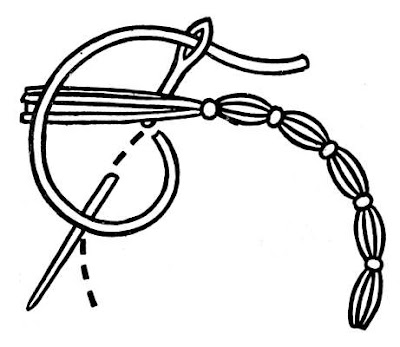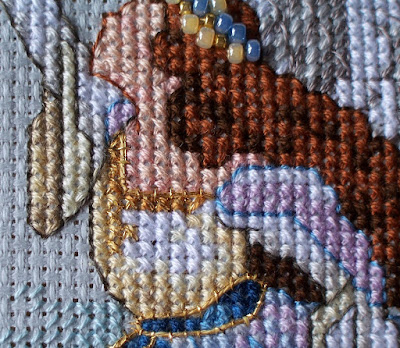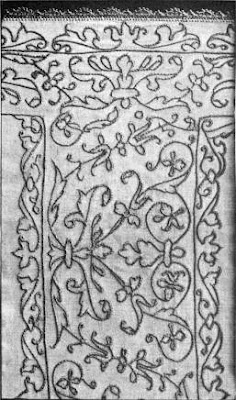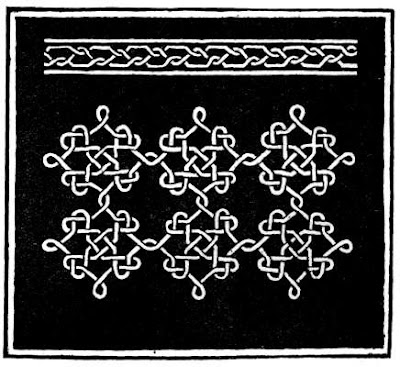Since I've been exploring couching for my
>Twilight Angel (my current WIP), and enjoyed stitching my test piece,
Couched Rose, so much, I've naturally been doing a bit of research on the technique and its applications. Surprisingly, the technique is so simple (lay a thread on the surface of your fabric, use a smaller thread to 'tack' it down at periodic intervals) that it really doesn't get much attention or in-depth application. Although the method of work is simple, especially when compared to more popular embroidery stitches, I think that that it has endless possibilities when you vary materials (you could couch threads, ribbons, braids, yarns, specialty fibers - anything you can stitch around, you can couch down!), colours and textures.
Plus, I think its versatility is overlooked. It works beautifully to outline other stitches or design elements (especially those with curves!), but it can also be laid in rows, or loops, or trellis patterns to make a simple but very striking filling!
And, while working with the fine threads I used for my
Couched Rose, I could easily imagine picking up a seed bead - or several! - with my "tacking thread" when I took a stitch, which might be an interesting look.
I find the possibilities very intriguing, and really hope that you will too!
Since my point of departure into learning about this stitch was my
>Twilight Angel, I first went to Dimensions (as she is a Dimensions Gold Petite kit) for further instruction. Although the kit directions specified which threads should be couched where, they did not include any stitching diagrams. Helpfully, there is a resource at the
Dimensions Needlecrafts website that shows the basics of the stitch.
Another resource I found helpful was a quick tutorial at
The Stitch School Blog, which is a project blog run by a graphic designer named Janet in Pennsylvania, that explains basic embroidery stitches to beginners like myself. She includes step-by-step photos, which is very helpful, especially since she uses contrasting thread colours (blue and red) for the "laid thread" and the "tacking thread".
The British magazine,
STITCH with The Embroiderer's Guild, has a longer "lesson" article called
Laying It On The Line, by Jan Beaney, that provides point-form stitch information followed by some very innovative uses of texture in fibre arts. While these works are far from cross-stitch, and cross into the "art textiles" world, it is useful as inspiration for experimenting with different materials.
Most designs play off width very well, using thin fibres and much thicker fibres in the same piece. This idea could be extended to various other contrasts as well: shiny vs. matte, fluffy vs. flat, fuzzy vs. neat, natural vs. synthetic. Oh, the possibilities! :)
Next, I went on to look at historical information, which was very enlightening.
The next three resources are antique books that are in the public domain, made available to everyone, by
Project Gutenberg. If you're not familiar with this site, all of the texts collected, on many diverse subjects, are available for free download, in a wide variety of formats, and are transcribed by volunteers who wish to facilitate the exchange of knowledge by providing copyright-free works to the public.
I have not produced the complete texts here, as they are rather lengthy. Rather, I'd like to give a quick review of the couching section only, with page numbers, so you can quickly navigate to that area of the document to have a look for yourself.
However, I have added in some diagrams, to give you an overview of the material.
The Handbook of EmbroideryView Online;
Download.
Section:
"Couching" or Laid Embroidery, pages 40-45.
Lady Alford opens this section by stating that: "
This name ["couching" or laid embroidery] is properly applied to all forms of embroidery in which the threads of crewel, silk, or gold are laid on the surface, and stitched on to it by threads coming from the back of the material."
She starts with "Plain Couching or Laid Embroidery", by which she means the traditional lay-and-tack method, illustrated as a filling for a scrollwork element:
Next, she describes two stitches without diagrams: "Net Couching": "
The fastening stitches are placed diagonally instead of at right angles, forming a network, and are kept in place by a cross-stitch at each intersection", (41) and "Brick Couching": "
The threads are laid down two together, and are stitched across at regular intervals. The next two threads are then placed together by the side, the fastening stitches being taken at the same distance from each other, but so as to occur exactly between the previous couplings. Thus giving the effect of brickwork" (41).
The curiously named "Diaper Couching" is described in more detail, and appears to be quite a versatile stitch: "
By varying the position of the fastening stitches different patterns may be produced, such as diagonal crossings, diamonds, zigzags, curves, etc.", as illustrated in this trio of stitch examples:
Lady Alford notes that this stitch was traditionally used in gold-work (embroidery with real-metal threads, often ecclesiastical), but could be adapted for silks.
Lastly, she addresses a more complicated variation, the "Basket Stitch", which is also more commonly worked in gold-work. Lady Alford writes: "
Rows of “stuffing,” manufactured in the form of soft cotton cord, are laid across the pattern and firmly secured. Across these are placed gold threads, two at a time, and these are stitched down over each two rows of stuffing. The two gold threads are turned at the edge of the pattern, and brought back close to the last, and fastened in the same way. Three double rows of gold may be stitched over the same two rows of stuffing. The next three rows must be treated as brick stitch, and fastened exactly between the previous stitchings, and so on, until the whole space to be worked is closely covered with what appears to be a golden wicker-work."
The rows of soft cotton serve to pad the "laid threads", lifting them off the fabric surface, while the tacking stitches serve to pull down and secure the thread sections, thus giving it a three-dimensional look. The staggered groupings of three tacking stitches result in the "woven" look, like a basket, or (viewed horizontally) like bricks.
Art in Needlework: A Book About Embroidery by Lewis F. Day and Mary Buckle, London: 1900.
View Online;
Download.
Section:
"Couching", pages 122-130.
The authors start off the section quite frankly by stating:
Couching is the sewing down of one thread by another...When a surface is covered with couching, as in the seeding of the flower in the sampler...the sewing down stitches make a pattern—all the plainer there, because the stitching is in a contrasting shade of colour. It is quite permissible to call attention to the stitching if it suits your artistic purpose. To disguise it by sewing through the cord is not a workmanlike practice. A worker should frankly accept a method of work and get character out of it." Okay, then!
They use a sampler for illustration:
This is followed by a section on couching with looped thread, which sounds very interesting; however, no information is given on how to work the stitch, and the picture is not illuminating. Also, although there is a bit of information on Reverse Couching, which occurs when the tacking thread is pulled so tightly that the tacking stitches "sink" to the reverse of the fabric, the illustrations (of front and back) are misleading, as the tacking stitches are worked over a large block of satin stitch, and this prevents the 'sinking' from occurring. If a single "laid thread" were used, it would appear to 'ident' where the tacking stitches have been taken.
This is pretty much the limit of the Couching section. However, the authors refer to diagrams that incorporate couching with other stitches in the
Laid Work section, and couching continues on into the next
section, Gold Couching (including Silver), and goes into the next
section on Applique as well.
Indeed, one of the most confusing aspects of this book is that it showcases illustrations of works that use many techniques, and so one is forever jumping through the sections trying to see what is being mentioned. And, since the illustrations are not labelled with the stitches used, it can be frustrating trying to figure out exactly what has been used where, and how! Thus,
Art in Needlework is more of an inspiration guide and history lesson than it is about any one technique.
By far, the best example of couching appears near the very end of the book:
This lovely example is referred to as "Simple Couching on Linen", and appears in the
section towards the end of the text called A Plea for Simplicity in which the authors appeal to the stitching public to bring back the simple stitches and forms that previously existed, stating (quite amusingly):
What one misses in the work of the present day is that reticent and unpretending stitchery, which, thinking to be no more than a labour of loving patience, is really a work of art, better deserving the title than a flaunting floral quilt which goes by the name of "art needlework"—designed apparently to worry the eye by day and to give bad dreams by night to whoever may have the misfortune to sleep under it."(!)
In this appeal, there is also a noted concern that the stitches of a stitchery stay visible - that the method of work be evident in the work itself, so that there is no resemblance to the new mechanically woven textiles, which heavily borrow the geometric forms and patterns of traditional peasant and ethnic embroidery. They add "
There is a similar objection nowadays to some stitches, such, for example, as chain-stitch and back-stitch, which suggest the sewing-machine."
Indeed, the whole text can be seen as a series of examples of hand stitchery designed to showcase the variation and beauty that can be achieved using different stitch methods; it is not a stitch guide or how-to manual, but rather a manifesto arguing for the preservation of traditional embroidery in the face of the increasing popularity of manufactured commodities. Reading
Art in Needlework is very eerie in that way, as it was well ahead of its time; the same argument could be made today.
I did not understand the emphasis that is placed on exhibiting the tacking stitches in the Couching section until I read the Plea (indeed, I had thought invisible tacking stitches were the pinnacle of couching success, unless they were deliberately made to be decorative!), when it became obvious that it was stressed in order to make the couching appear 'hand done' instead of 'machine made'. Interesting thought!
And finally, we have the most straight-forward text of all (despite its name!):
Embroidery And Tapestry Weaving: A Practical Text-Book of Design and Workmanship By Mrs. Archibald H. Christie with Drawings By The Author And Other Illustrations, The Artistic Crafts Series of Technical Handbooks, by Grace Christie, London: 1912.
View Online;
Download
Section:
Methods of Work, Chapter VII (not paginated).
The book opens with this quote:
"Flowers, Plants and Fishes, Birds, Beasts, Flyes, and Bees,
Hils, Dales, Plaines, Pastures, Skies, Seas, Rivers, Trees,
There's nothing neere at hand, or farthest sought,
But with the needle may be shap'd and wrought."
—John Taylor ("The Praise of the Needle").
The most recent book, Embroidery and Tapestry Weaving, is a very informative text, and is written in an easily understandable manner with very practical illustrations. There are a great many other embroidery stitches covered in this book, which makes it a good starting point for beginning embroiderers (like myself!).
Christie defines couching this way: "Couching is the name given to a method of embroidery in which one thread is attached to the material by another one. Sometimes not only one thread but a number of threads are couched down together; or it may be cord, braid, or metal thread that is attached to the material in this way." She notes that although couching is often used in gold-work, it is best worked in a special technique more suitable for the fragile real metal threads, and states that gold-work couching methods are not to be used with regular embroidery materials. This is useful to know!
This text has a wonderfully clear diagram of in-process couching:

She talks about the versatile nature of the stitch, and provides another illustration of couched work used as a filling for a shape (in this case, a rectangle):
Christie then addresses two very novel and interesting uses of couching: "Braid Work" and "Strap Work". Braid Work is as the name implies - couching using braided trim for your "laid thread". Although it takes extra effort to get the edges of the braid to the back of your work for darning, she notes that the thick braid has a wonderful texture is most suitable for what she terms "Strap Work", or works that consist of interlaced lines, like this example:
The illustration design has a lovely Celtic Knot like effect, and would be suitable for other materials that could more easily be passed through to the back of the fabric. I believe, from the description, that the braid is meant to be passed on the surface when doing Strap Work, but if one was to use embroidery thread, it might be possible to go down into the back at the end of each line.
Christie notes that "Curves and sharp corners need special attention by way of extra stitches", which is what I realized when I was working my Couched Rose.
Interestingly, the Laid Work is also addressed, not as a different stitch but as "couching on a more extended scale—a given space is covered with threads taken from side to side in parallel lines close together, fixed at either extremity by entering the material". There are different ways to work the stitches that tack down the laid work, and couching is only one of them. But she suggests that couching can be combined with laid work and other stitches for a very pleasing result, and includes this stitch diagram:
This simple flower is filled with Laid Work, held down with the spirals of Couching (the black marks are the tacking stitches), and the center is a checkerboard of Couching with French Knots in the middle! The outline of the flower is also worked in Couching, presumably with a different colour.
The mix of textures here is quite intriguing!
hristie includes another diagram, of a leaf, to further illustrate that Couching makes a wonderful and neat outline (and overlay - leaf veining, in this case) to laid work, which is liable to have uneven edges that can look quite unsightly.
Of the three antique books reviewed, this is the shortest section on Couching but is, perhaps, the most informative, for the clarity of its diagrams.
I hope that you've enjoyed this review of helpful couching resources!
This article turned out rather longer than I had intended, but if you are interested in the technique, I think you'll find something of interest here.
Truthfully, I hadn't expected to find much information in the historical books I looked at, but was very pleasantly surprised. With the increasing amount of public-domain books becoming available, I am glad to see that the embroidery books are being transcribed, as they still have relevance today, especially when trying to find information on lesser known stitches - like couching! - and different ways to work stitcheries. It is also nice, I think, to read about the history of the craft and the ways that older stitching was worked. <
After all, it's always beneficial to learn the "rules", so that you can break them! ;)




























